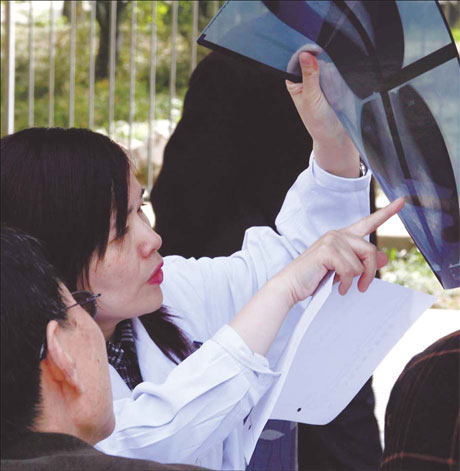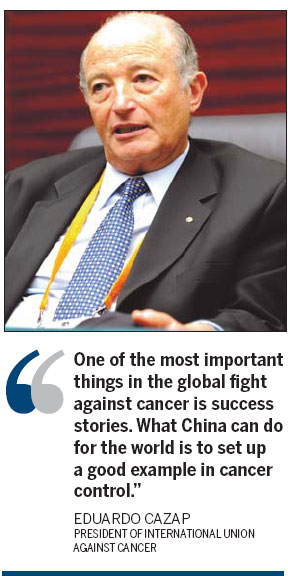
Growing affluence and a sedentary lifestyle have led to cancer emerging as the No 1 killer in the country. But targeted efforts in prevention can still turn the tide, say experts. Ye Jun reports
Cancer has emerged as the nation's No 1 killer with its incidence increasing by 80 percent in the past 30 years. Every year, 2.6 million people get cancer, and 1.8 million succumb to it.
These figures were revealed by Health Minister Chen Zhu, at the 21st World Cancer Congress held recently in Shenzhen, Guangdong province.
This rise in cancer can be attributed to the country's rapid social and economic changes, says Hao Xishan, president of the Chinese Anti-Cancer Association (CACA).
"With greater affluence, the number of smokers has gone up. People are also consuming more eggs and meat, and this is contributing to obesity," says Hao, also an academician with the Chinese Academy of Sciences.
"Again, more Chinese are driving cars, and spending ever greater hours in front of the computer and TV, while getting very little physical exercise everyday."
Hao also points out that the increase in life expectancy means greater numbers of those afflicted with cancer as it is a high-risk disease for those in the 55-70 age group.
The holding of the Congress - held for the first time in China - is very timely, he adds.
Held jointly by the International Union Against Cancer (UICC), the Chinese Medical Association and the CACA, the theme this year was "preventing the preventable, treating the treatable - system to make it happen".

Founded in 1933, UICC headquartered in Geneva, Switzerland, and has 375 member organizations in more than 100 countries.
According to Eduardo Cazap, president of UICC, cancer kills more people globally than AIDS, malaria and TB combined. Nearly 12.7 million cases and 7.6 million deaths from cancer were reported in 2008.
These numbers are expected to double over the next 20-40 years, with the greatest increase in low and middle-income countries.
Dr Christopher P Wild, director of the International Agency for Research on Cancer in Lyon, France, says that of the new cancer cases worldwide, 5.6 million are in developed regions, and 7.1 million in less developed regions. At the global level, the top six cancers are lung, breast, colorectal, stomach, prostate and liver.
The most common types of cancer in China are lung, liver, stomach, oesophagal, and colorectal.
"There are still a lot of misunderstanding about cancer in China," Hao of the CACA says. "People think cancer is not a curable disease. They also think it costs so much that they cannot afford the treatment and hence feel it is useless to check for it. Some cancer patients even feel guilty, believing it is some kind of retribution."
P Butow of Sydney, Australia, told the Congress that is common for patients to react with shock, guilt, fear, and depression and suggests better doctor- and nurse-patient communication.
Grassroots doctors in Guangdong and Shanghai, working to screen cancer patients for early treatment, point out that early screening is not always effective.
In Tianjin, for example, only 54 percent of people who registered for screening actually showed up.
"Cancer is not a mystery," emphasizes David Hill, former president of the UICC. "It's a disease we have a lot of knowledge about. The public has the right to proper knowledge to prevent the disease."
Cazap says the Congress has brought the world's best experts to China, so that Chinese medical professionals have a chance to improve and communicate. China can also do a lot for the world. "One of the most important things in the global fight against cancer is success stories," Cazap says. "What China can do for the world is to set up a good example in cancer control."
Although China has ratified WHO's Framework Convention on Tobacco Control, there is still a lot of work to do, points out CACA's Hao.
"Tax on tobacco products should be raised to use for tumor treatment. Non-smokers should be protected from second-hand smoke in public spaces," he says.
"Professional organization should offer more support for people to quit smoking."
Hao also suggests the government subsidize healthy foods such as corn products to prevent colorectal cancer.
"China has a lot to learn from developed countries in terms of government policy, professional expertise, and social education," he adds.
The level of tumor treatment technology in big hospitals and the quality of tumor treatment centers in China do not differ much from that in Western countries, according to Hao. But resources are unbalanced, with remote areas facing a serious lack of proper medical equipment, such as mammography.
Hao estimates that 40-50 percent of pain alleviation services in China do not match up to Western standards. There is a lack of pain clinics, and proper training to alleviate pain.
While in the West, doctors keep patients informed about their condition, many Chinese cancer patients are still kept in the dark.
"Without psychological assessment, the work of a tumor center is not comprehensive enough," Hao says. "Psychological and emotional support should be as common as measuring temperature and blood pressure in hospitals."
He estimates the nation could see a decline in the incidence of cancer in 15-20 years, if all prevention and treatment policies are properly carried out.
taken from : China Daily


No comments:
Post a Comment